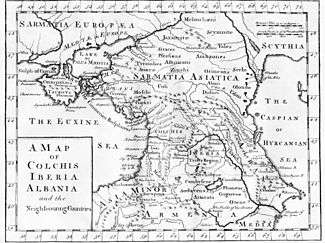Serboi
Serboi (Σέρβοι, tr. Sérvoi; also Sirboi, Serbi) is an ethnonym recorded in Greco-Roman ethnography. It designated an Iranian tribe[1] dwelling in Asiatic Sarmatia (north Caucasus), probably by the Lower Volga River.
Original appearances in Caucasus
Pliny the Younger in his work Plinii Caecilii Secundi Historia naturalis from the first century AD (69–75) mentioned people named Serbi,[2] who lived near the Cimmerians, presumably on the Black Sea and the Sea of Azov.
In the 2nd century (around 175 AD), the Egyptian scientist Claudius Ptolemy mentioned in his Geography people named Serboi or Sirboi,[2] who presumably lived behind the Caucasus, in the hinterland of the Caspian Sea in present-day Astrakhan.
-

"Serbi" located near the mouth of the Volga, based on Greek literary sources, in a map printed by an unknown publisher in London, ca 1770
-

People with name Sirbi near the estuary of the river Volga, on a Ptolemaic map revised and printed by Sebastian Münster in 1552.
-

People with name Sirbi near the estuary of the river Volga, on a Ptolemaic map published by Girolamo Porro in Venice, 1598
-
People with the name Сербьи (Серби, Serbi) near the estuary of the river Volga, according to the map from the book of Jovan Rajić, printed in Vienna in 1794.
Later appearances in Caucasus
In the 10th century, Byzantine emperor Constantine VII Porphyrogennetos (912–959) mentioned in his book De Ceremoniis two tribes named Krevatades (Krevatas) and Sarban (Sarbani), which some researches identified as Croats and Serbs. These tribes were located in the Caucasus near the river Terek, between Alania and Tsanaria.[3][4][5][6] The Sarban tribe in the Caucasus in the 10th century was also recorded by an Arab geographer.[7]
Later appearances in Central Europe and the Balkans
Names in same or similar forms (Surbii, Suurbi, Serbloi, Sorabi, Surben, Sarbi, Serbii, Serboi, Zirbi, Surbi, Sorben) were later used by various authors to designate South-Slavic Serbs in the Balkans and Western Slavic Sorbs in Lusatia.[8]
Theory about Iranian origin of the Serbs assumes that ancient Serbi / Serboi from north Caucasus were an Sarmatian (Alanian) tribe.[9] The theory subsequently assumes that Alanian Serbi were subdued by the Huns in the 4th century and that they, as part of the Hunnic army, migrated to the western edge of the Hunnic Empire (in the area of Central Europe near the river Elbe, later designated as White Serbia in what is now Saxony (eastern Germany) and western Poland). After Hunnic leader Attila died (in 453), Alanian Serbi presumably became independent and ruled in the east of the river Saale (in modern day Germany) over local Slavic population.[10][9] Over time, they, it is argued, intermarried with the local Slavic population of the region,[10][9] adopted Slavic language, and transferred their name to the Slavs.[11] According to Tadeuš Sulimirski, similar event could occur in the Balkans or Serbs who settled in the Balkans were Slavs who came from the north and who were ruled by already slavicized Alans.[10]
See also
References
- ↑ John Van Antwerp Fine (1991). "The Early Medieval Balkans: A Critical Survey from the Sixth to the Late Twelfth Century". University of Michigan Press. line feed character in
|title=at position 28 (help), p. 56; around the time of Christ there was an Iranian tribe on the Don known to Greek geographers as Serbi-Serboi - 1 2 Aleksandar M. Petrović, Arheografija naroda jugoistočne Evrope, Beograd, 2006, page 19.
- ↑ De administrando imperio, Constantine VII Porphyrogenitus (Emperor of the East), Gyula Moravcsik, Pázmány Péter Tudományegyetemi Görög Filológiai Intézet, 1949, page 115.
- ↑ Parameśa Caudhurī, India in Kurdistan, Qwality Book Company, 2005, page 79.
- ↑ The Slavs: their early history and civilization, Francis Dvornik, American Academy of Arts and Sciences, 1959, page 28.
- ↑ Constantini Porphyrogenneti... libri duo De ceremoniis aulæ Byzantinæ. Prodeunt nunc primum Græce, cum Latina interpretatione et commentariis. Curarunt Io. Henricus Leichius et Io. Iacobus Reiskius..., VII Constantin, Gleditschius, 1754, page 397.
- ↑ The early medieval Balkans: a critical survey from the sixth to the late twelfth century, John Van Antwerp Fine, University of Michigan Press, 1991, page 56.
- ↑ Živko D. Petković, Prve pojave srpskog imena, Beograd, 1996, page 9.
- 1 2 3 Miodrag Milanović, Srpski stari vek, Beograd, 2008, page 81.
- 1 2 3 Relja Novaković, Još o poreklu Srba, Beograd, 1992, page 46.
- ↑ Relja Novaković, Još o poreklu Srba, Beograd, 1992, page 48.